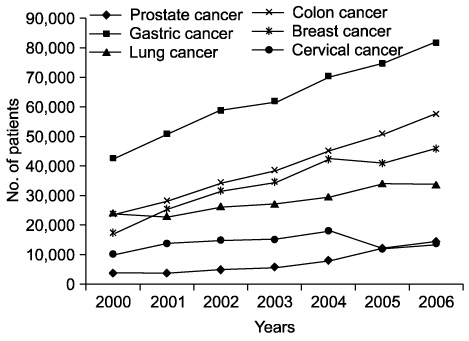Korean J Urol.
2009 Nov;50(11):1054-1058.
Epidemiologic Characteristics of Prostate Cancer Detection
- Affiliations
-
- 1Department of Urology, Chonbuk National University Medical School, Jeonju, Korea. rain@chonbuk.ac.kr
- 2Institute for Medical Sciences of Chonbuk National University Medical School, Jeonju, Korea.
- 3Research Institute of Clinical Medicine, Chonbuk National University, Jeonju, Korea.
- 4Clinical Trial Center of Chonbuk National University Hospital, Jeonju, Korea.
Abstract
- PURPOSE
The prevalence of prostate cancer is increasing in the general population. This study aimed to evaluate the epidemiologic characteristics of the prostate cancer detection rate.
MATERIALS AND METHODS
We analyzed data from patients who underwent transrectal ultrasound-guided prostate biopsy and who were newly diagnosed with prostate cancer from 2005 to 2006 in Korea. These data were based on National Health Insurance statistics. We also analyzed the data of patients who underwent transrectal ultrasound-guided prostate biopsy and were newly diagnosed with prostate cancer in our institution from 2005 to 2007.
RESULTS
According to the data of the National Health Insurance, the detection rates of prostate cancer were 45.8% in 2005 and 43.1% in 2006. These results were not actual cancer detection rates. According to the data from our institution, the cancer detection rate ranged from 24.8% to 25.9% compared with the 15.5% to 23% cancer detection rate reported by other Korean studies. We analyzed the reasons for this difference in detection rates and suggest that the difference is because a suggestive diagnosis is useful and is unchanged until the diagnosis is confirmed.
CONCLUSIONS
The prevalence of prostate cancer is increasing more rapidly than that of other major cancers. The detection rate of prostate cancer in Korean patients who underwent transrectal ultrasound-guided prostate biopsy was inferior to that in Caucasians. Also, some patients were detected without proper screening or biopsy and were thus diagnosed as having advanced or metastatic prostatic cancer. We need a good corelationship between National Health Insurance and the cancer registration project for real detection of prostate cancer.
MeSH Terms
Figure
Reference
-
1. Jemal A, Tiwari RC, Murray T, Ghafoor A, Samuels A, Ward E, et al. Cancer statistics, 2004. CA Cancer J Clin. 2004. 54:8–29.2. Pu YS, Fujimoto H, Kakizoe T, Myers R. The 18th international symposium: controversies in prostate cancer diagnosis and treatment. Jpn J Clin Oncol. 2005. 35:680–689.3. Park SK, Sakoda LC, Kang D, Chokkalingam AP, Lee E, Shin HR, et al. Rising prostate cancer rates in South Korea. Prostate. 2006. 66:1285–1291.4. Jung KW, Yim SH, Kong HJ, Hwang SY, Won YJ, Lee JK, et al. Cancer survival in Korea 1993-2002: a population-based study. J Korean Med Sci. 2007. 22:Suppl. S5–S10.5. Kwon JK, Chang IH, Kim TH, Myung SC. Changes in prostate cancer pattern according to prostate-specific antigen screening test. Korean J Urol. 2009. 50:439–444.6. Song K, Song C, Ahn H. Continuing trends of the clinical parameter migration in patients with prostate cancer in Korea. Korean J Urol. 2007. 48:574–578.7. Seong DH, Cho JS, Hong SJ, Chung BH, Choi YD, Kim SJ, et al. The influence of age and prostate volume on the cancer detection rate in Korean men with PSA levels of 4.0 to 10.0 ng/ml: a multicenter, retrospective study. Korean J Urol. 2006. 47:353–357.8. Catalona WJ, Richie JP, Ahmann FR, Hudson MA, Scardino PT, Flanigan RC, et al. Comparison of digital rectal examination and serum prostate specific antigen in the early detection of prostate cancer: results of a multicenter clinical trial of 6,630 men. J Urol. 1994. 151:1283–1290.9. Meshref AW, Bazinet M, Trudel C, Aronson S, Peloquin F, Nachabe M, et al. Role of prostate-specific antigen density after applying age-specific prostate-specific antigen reference ranges. Urology. 1995. 45:972–979.10. Schröder FH, Van der Cruijsen-Koeter I, de Koning HJ, Vis AN, Hoedemaeker RF, Kranse R. Prostate cancer detection at low prostate specific antigen. J Urol. 2000. 163:806–812.11. Morote J, Raventos CX, Lorente JA, Lopez-Pacios MA, Encabo G, de Torres I, et al. Comparison of percent free prostate specific antigen and prostate specific antigen density as methods to enhance prostate specific antigen specificity in early prostate cancer detection in men with normal rectal examination and prostate specific antigen between 4.1 and 10 ng/ml. J Urol. 1997. 158:502–504.12. Kobayashi T, Nishizawa K, Ogura K, Mitsumori K, Ide Y. Detection of prostate cancer in men with prostate-specific antigen levels of 2.0 to 4.0 ng/mL equivalent to that in men with 4.1 to 10.0 ng/mL in a Japanese population. Urology. 2004. 63:727–731.13. Yamamoto S, Ito T, Aizawa T, Noda K, Umezu K, Ohtsuru N, et al. Dose transrectal ultrasound guided eight-core prostate biopsy improve cancer detection rates in patients with prostate-specific antigen levels of 4.1-10 ng/mL? Int J Urol. 2004. 11:386–391.14. Jung JY, Jeong H, Chung J, Lee SB, Lee SE, Kim SH. The outcome of TRUS-guided sextant biopsy according to prostate volume. Korean J Urol. 2000. 41:505–511.15. Jung BC, Kim TH, Jeong SJ, Kwak C, Lee SE. The clinical usefulness of the prostate-specific antigen, prostate-specific antigen density, digital rectal examination, and transrectal ultrasonography in the screening test of prostate cancer in Koreans. Korean J Urol. 2002. 43:14–18.16. Lee SC, Lee SC, Kim WJ. Value of PSA density, PSA velocity and percent free PSA for detection of prostate cancer in patients with serum PSA 4-10 ng/ml patients. Korean J Urol. 2004. 45:747–752.
- Full Text Links
- Actions
-
Cited
- CITED
-
- Close
- Share
- Similar articles
-
- Multiparametric MRI in the Detection of Clinically Significant Prostate Cancer
- Prostate Cancer Detection Rate According to Prostate Volume and Age With PSA Levels of above 4.0ng/ml
- The prostate specific antigen in detection of the prostate cancer
- The Prostate Cancer Detection Rate on the Second Prostate Biopsy according to Prostate-Specific Antigen Trend
- Is it Appropriate to Lower the Prostate Specific Antigen Cut-off Value to 2.5 ng/ml for Prostate Biopsy in Korean?



